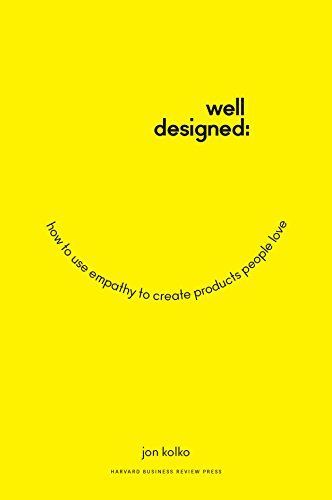
Well-designed How to Use Empathy to Create Products People Love
"A new way to create-and then disrupt Industry disruption is no longer isolated to a unique product or service. Today's consumer needs engagement in order to be swayed to interact, connect, and buy your next offering. Achieve this and you'll achieve success. Sharp and refreshing, design insider and expert Jon Kolko offers a new view and usable process for conceiving and building powerful, emotionally resonant new products in this new book. In Well-Designed, Kolko-VP at MyEdu and Founder and Director of the Austin Center for Design--shows how deep, meaningful engagement happens when products and services are delivered in an authentic way, when consumers see them less like manufactured artifacts and more like good friends. The key is empathy-driven design thinking, using a process of storytelling and iteration, with results that provoke emotion, change behavior, and create deep engagement. Kolko, who has been engaged in this process of design for more than 15 years, now shares a concrete set of steps for identifying lucrative opportunities, designing for innovation, and producing products that have deep, meaningful emotional engagement. By following this process, readers will learn how to raise the role of design to a strategic competency"--
Reviews
ebrar@ebrar
PG Gonni@sekei
Dharmesh Mehta@dm
Ron Bronson@ron
Ellen Chisa@ellenchisa
chris@chrees
Jacob Munk-Stander@jacobms
Joshua Line@fictionjunky
Gareth Kay@garethk
Peter Polgar@polgarp
Victoria Simansjah@vicky
Lars@larsrose
Highlights
PG Gonni@sekei
Page 214
PG Gonni@sekei
Page 206
PG Gonni@sekei
Page 202
PG Gonni@sekei
Page 199
PG Gonni@sekei
Page 192
PG Gonni@sekei
PG Gonni@sekei
Page 175
PG Gonni@sekei
Page 173
PG Gonni@sekei
Page 166
PG Gonni@sekei
Page 161
PG Gonni@sekei
Page 137
PG Gonni@sekei
Page 134
PG Gonni@sekei
Page 128
PG Gonni@sekei
Page 122
PG Gonni@sekei
Page 104
PG Gonni@sekei
Page 101
PG Gonni@sekei
Page 93
PG Gonni@sekei
Page 90
PG Gonni@sekei
Page 62
PG Gonni@sekei
Page 58
PG Gonni@sekei
Page 51
PG Gonni@sekei
Page 49
PG Gonni@sekei
Page 33
PG Gonni@sekei
Page 27